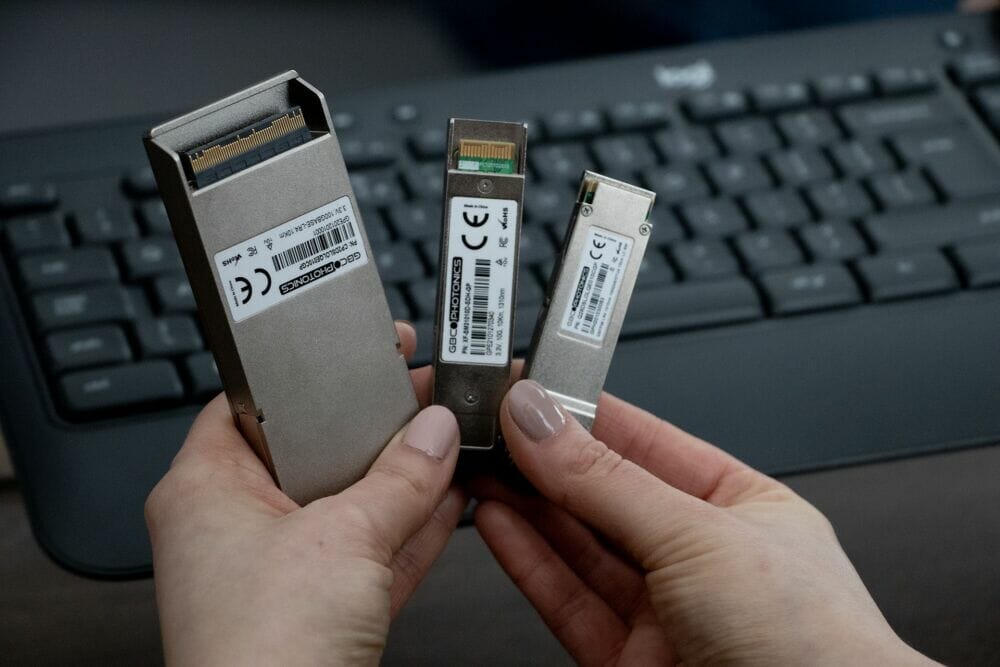The high amount of branded optical transceivers and interfaces on the market means that, when setting up a new fibre optic link, incompatibility issues are frequent. Here Marcin Bala, CEO of telecommunications equipment manufacturer GBC Photonics, explains how universal transceivers can help.
The ample choice of providers and their comprehensive product portfolios means that network operators can select the products that most respond to their needs. However, this comes with pain points, such as the necessity to source transceivers that are compatible with the rest of the equipment.
To make the process easier, network operators can deploy universal transceivers instead, reconfiguring transceivers thanks to GBC Photonics’ Simple Recode Device (SRD), distributed by Salumanus. The SRD allows users to alter the configuration of different types of transceivers — SFP/ SFP+/ SFP28/ XFP/ QSFP+/ QSFP28/ QSFP-DD/ CFP/ CFP2/ CFP4 — by modifying their memory in accordance with the appropriate MSA standard.
As a result, users will be able to cover four different transmission speeds with just one transceiver: 10 GbE, 25 GbE, 8.83 Gbps CRPI and 24.33 Gbps eCRPI, with a transmission range of 80 km for 10 GbE and 10 km for 25 GbE. They can also obtain a transceiver that is completely host agnostic and supports both single and dual fibre applications.
The easy reconfiguration process guarantees compatibility and offers a wealth of other benefits on top.
Easier implementation
Dealing with a wide variety of optical transceivers and interfaces can be frustrating and time-consuming — even after careful consideration, there’s always the chance that your transceiver of choice won’t be supported by the device you need to set up.
The causes can be many, such as human error, incorrect or incomplete inventory information, or communication problems with the client. Regardless of the reason, the only solution is to replace the transceiver. Operators will waste time going back and forth from the warehouse, and if the new transceiver is not in stock, the implementation will have to be postponed.
With a universal transceiver, operators will save time and money, leading to a more efficient implementation and to increased customer satisfaction.
Inventory management
When the amount of components in stock starts to build up, teams can spend too much time tracking down inventory and can ultimately make mistakes and select the wrong parts for a given installation.
However, telco operators normally need to stock equipment from a variety of providers, usually two for OTN/DWDM networks, two for routers and switches and sometimes a different one for firewall purposes.
A customer might need five units of each interface type — SFP, SFP+, QSFP+ and QSFP28 — for a total of 20 stock keeping units (SKUs). Because each SKU needs to be compatible with the hardware solution of each vendor, in the case of the five vendors mentioned above we will have a total of a hundred different parts.
For each part, operators will have to forecast the right quantity, negotiate prices, process orders, and finally keep the part in stock. Universal transceivers could reduce this number to just 20, eliminating hardware redundancies and helping operators make the most of their inventory space.
This can also be a blessing at times of supply chain shortages, when lead times to source new optical transceivers can be several months.
Easy upgrades and more flexibility
Excessive latency and slow processing speed, the intention of growing the business, or the need for more bandwidth are all great reasons to upgrade fibre networks. However, the initial investment in hardware is sometimes one of the reasons why companies postpone upgrades that could substantially improve performance.
Universal transceivers facilitate this process by minimising the need to invest in new equipment, as well as reducing lead times for implementation. For example, if the upgrade requires the integration of equipment from a new vendor in the network infrastructure — for example, replacing all Juniper switches with Nokia switches, or vice versa — the company can simply reconfigure its existing transceivers without buying new ones, keeping costs down while reducing the chances of equipment mismatch.
Reduced environmental footprint
The Global E-Waste Monitor warned that in 2019, 53.6 million tonnes of e-waste were produced globally. This is an increase of 2 million tonnes from the previous year, the equivalent of 200 Eiffel Towers. The same source predicts that e-waste will increase to 74.7 million tonnes by 2030. The telecommunications industry must do its part to prevent the catastrophic impact of pollution from e-waste, and one way of doing this is by minimising hardware redundancies.
A universal transceiver means that when a network operator decides to implement equipment from a new vendor in their network infrastructure, they won’t need to discard their existing transceivers and buy new ones to match. Instead, they can simply reconfigure them and keep them in operation for as long as possible.
The pressure to stay competitive, together with the global responsibility to deliver more sustainable solutions, is pushing network operators to choose vendor agnostic equipment that can be easily repurposed. Universal optical transceivers are an important way of achieving these goals, and one that network operators shouldn’t overlook.
To learn more about universal transceivers and the GBC Photonics’ Simple Recode Device, visit our website.







